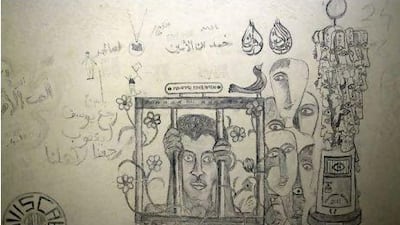TRIPOLI // The cell walls of Tripoli's notorious Abu Selim prison are mute testimony to the yearnings of the Libyans held there by the Qaddafi regime.
Photos of Mecca, Al Aqsa, a palm tree, an SUV and an airplane lifting into the sky adorn one wall. On another, a rough hand-drawn map of North America, another of Asia.
With each photo and drawing, there is the inescapable sense of prisoners longing for ordinary life and the inspiration to endure. Then the true horror of the place is revealed. On the next wall, written with a shaky pencil, is a prayer and the words, "Save me."
In 1996, this prison was the site of an inmate rebellion crushed in blood, where Muammar Qaddafi's henchmen killed 1,200 prisoners and then buried them in the prison courtyard, where a dusty lawn and a huge white plastic tent now stands.
For the rebels, staking their flag on Abu Selim was a victory charged with symbolism. It was a February demonstration in Benghazi organised by families of the 1996 victims that sparked the revolt that drove Col Qaddafi from power.
Pictures of the victims of the massacre have been displayed everywhere in eastern Libya since the beginning of the uprising. Most of them were in jail simply for opposing the Qaddafi government.
On Wednesday, rebel forces seized the Tripoli neighbourhood of Abu Selim, one of the last residential neighbourhoods still under Col Qaddafi's control. Rebels fought hard to take control of the area. At a roundabout near the entrance to Abu Selim, about 20 corpses of regime fighters lay on the street decomposing.
Abu Selim prison was empty on Friday, littered with trash. The small cell doors were swung open. Inside, the inmates' laundry was still hanging on clothes lines, and straw mats were scattered on the floor, proving that prisoners fled in haste.
Zakaria Al Fitouri, 37, was one of the prisoners freed a few days earlier. He was arrested at the beginning of the uprising for his political activities. On Friday, he was helping rebels take away medical supplies from the prison's clinic.
"We were six in a very small room. The food was terrible and we were constantly insulted until Wednesday when the guards fled while the battle was raging around us and local residents came to set us free," Mr Al Fitouri said.
Inmates arrested for weapons possession at the beginning of the uprising suffered particularly harsh treatment.
"Force was used to extort information from them," said Nasser Saraj, a doctor arrested on June 7 for taking down a picture of Col Qaddafi from his hospital office wall.
Abdallah Matouk saw first-hand the massacre at Abu Selim, where he was held from 1991 to 2001. He was jailed, he said, for being too pious a Muslim when Col Qaddafi was at war with Islamists in the country.
The massacre, he said, came after some hundreds of inmates took control of the prison. They were convinced to go back to their cells in exchange for better living conditions.
Instead, guards re-entered the prison and opened fire.
foreign.desk@thenational.ae

